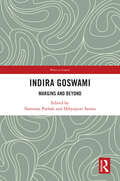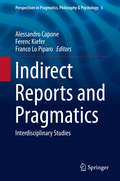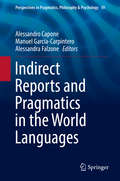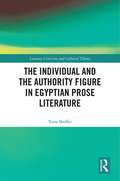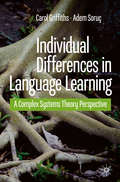- Table View
- List View
Indigenous Voices in Digital Spaces
by Cindy TekobbeIndigenous Voices in Digital Spaces applies Indigenous frameworks and epistemologies to online cultural movements through four case studies, including hashtags, memes, cryptocurrency, and digital artistry, and develops decolonizing practices for digital rhetoric, online identity work, and digital literacy practices. Tekobbe’s methods for analyzing and understanding Indigenous knowledges online center Indigenous storytelling and “thick” (broad, deep, and complex) Indigenous meaning-making. Employing this thickness to interpret Indigenous knowledge ways resists the settler-colonial logics that tend to flatten complex Indigenous concepts into one-note representations of racial stereotypes. Native Americans’ use of social media and digital platforms to support social movements uniquely constructs Indigenous identities as living, producing, and culture-making people, which confronts the commonplace, one-dimensional narrative that Indigenous North Americans either live in isolation or are people of history resigned to the long-forgotten past. Tekobbe’s methods are applicable to additional online research to break through Western paradigms of oppositional critique, the colonial power matrix embedded in hierarchical and taxonomical classification systems, and participant objectification. Indigenous Voices in Digital Spaces offers new methodological and epistemological opportunities to explore digital communities and technologies, problematizing conventional Western critique. This book is useful to instructors in Indigenous studies, internet studies, digital literacies, cultural studies, and communications, as well as Indigenous and internet studies researchers.
Indigenous Youth and Multilingualism: Language Identity, Ideology, and Practice in Dynamic Cultural Worlds
by Leisy T. Wyman Teresa L. McCarty Sheilah E. NicholasBridging the fields of youth studies and language planning and policy, this book takes a close, nuanced look at Indigenous youth bi/multilingualism across diverse cultural and linguistic settings, drawing out comparisons, contrasts, and important implications for language planning and policy and for projects designed to curtail language loss. Indigenous and non-Indigenous scholars with longstanding ties to language planning efforts in diverse Indigenous communities examine language policy and planning as de facto and de jure – as covert and overt, bottom-up and top-down. This approach illuminates crosscutting themes of language identity and ideology, cultural conflict, and linguistic human rights as youth negotiate these issues within rapidly changing sociolinguistic contexts. A distinctive feature of the book is its chapters and commentaries by Indigenous scholars writing about their own communities. This landmark volume stands alone in offering a look at diverse Indigenous youth in multiple endangered language communities, new theoretical, empirical, and methodological insights, and lessons for intergenerational language planning in dynamic sociocultural contexts.
Indigenous Youth and Multilingualism: Language Identity, Ideology, and Practice in Dynamic Cultural Worlds
by Leisy T. Wyman Teresa L. Mccarty Sheilah E. NicholasBridging the fields of youth studies and language planning and policy, this book takes a close, nuanced look at Indigenous youth bi/multilingualism across diverse cultural and linguistic settings, drawing out comparisons, contrasts, and important implications for language planning and policy and for projects designed to curtail language loss. Indigenous and non-Indigenous scholars with longstanding ties to language planning efforts in diverse Indigenous communities examine language policy and planning as de facto and de jure – as covert and overt, bottom-up and top-down. This approach illuminates crosscutting themes of language identity and ideology, cultural conflict, and linguistic human rights as youth negotiate these issues within rapidly changing sociolinguistic contexts. A distinctive feature of the book is its chapters and commentaries by Indigenous scholars writing about their own communities. This landmark volume stands alone in offering a look at diverse Indigenous youth in multiple endangered language communities, new theoretical, empirical, and methodological insights, and lessons for intergenerational language planning in dynamic sociocultural contexts.
The Indignant Generation: A Narrative History of African American Writers and Critics, 1934-1960
by Lawrence P. JacksonThe Indignant Generation is the first narrative history of the neglected but essential period of African American literature between the Harlem Renaissance and the civil rights era. The years between these two indispensable epochs saw the communal rise of Richard Wright, Gwendolyn Brooks, Ralph Ellison, Lorraine Hansberry, James Baldwin, and many other influential black writers. While these individuals have been duly celebrated, little attention has been paid to the political and artistic milieu in which they produced their greatest works. With this commanding study, Lawrence Jackson recalls the lost history of a crucial era. Looking at the tumultuous decades surrounding World War II, Jackson restores the "indignant" quality to a generation of African American writers shaped by Jim Crow segregation, the Great Depression, the growth of American communism, and an international wave of decolonization. He also reveals how artistic collectives in New York, Chicago, and Washington fostered a sense of destiny and belonging among diverse and disenchanted peoples. As Jackson shows through contemporary documents, the years that brought us Their Eyes Were Watching God, Native Son, and Invisible Man also saw the rise of African American literary criticism--by both black and white critics. Fully exploring the cadre of key African American writers who triumphed in spite of segregation, The Indignant Generation paints a vivid portrait of American intellectual and artistic life in the mid-twentieth century.
The Indignant Generation: A Narrative History of African American Writers and Critics, 1934-1960
by Lawrence P. JacksonThe Indignant Generation is the first narrative history of the neglected but essential period of African American literature between the Harlem Renaissance and the civil rights era. The years between these two indispensable epochs saw the communal rise of Richard Wright, Gwendolyn Brooks, Ralph Ellison, Lorraine Hansberry, James Baldwin, and many other influential black writers. While these individuals have been duly celebrated, little attention has been paid to the political and artistic milieu in which they produced their greatest works. With this commanding study, Lawrence Jackson recalls the lost history of a crucial era. Looking at the tumultuous decades surrounding World War II, Jackson restores the "indignant" quality to a generation of African American writers shaped by Jim Crow segregation, the Great Depression, the growth of American communism, and an international wave of decolonization. He also reveals how artistic collectives in New York, Chicago, and Washington fostered a sense of destiny and belonging among diverse and disenchanted peoples. As Jackson shows through contemporary documents, the years that brought us Their Eyes Were Watching God, Native Son, and Invisible Man also saw the rise of African American literary criticism--by both black and white critics. Fully exploring the cadre of key African American writers who triumphed in spite of segregation, The Indignant Generation paints a vivid portrait of American intellectual and artistic life in the mid-twentieth century.
The Indignant Generation: A Narrative History of African American Writers and Critics, 1934-1960
by Lawrence P. JacksonThe Indignant Generation is the first narrative history of the neglected but essential period of African American literature between the Harlem Renaissance and the civil rights era. The years between these two indispensable epochs saw the communal rise of Richard Wright, Gwendolyn Brooks, Ralph Ellison, Lorraine Hansberry, James Baldwin, and many other influential black writers. While these individuals have been duly celebrated, little attention has been paid to the political and artistic milieu in which they produced their greatest works. With this commanding study, Lawrence Jackson recalls the lost history of a crucial era. Looking at the tumultuous decades surrounding World War II, Jackson restores the "indignant" quality to a generation of African American writers shaped by Jim Crow segregation, the Great Depression, the growth of American communism, and an international wave of decolonization. He also reveals how artistic collectives in New York, Chicago, and Washington fostered a sense of destiny and belonging among diverse and disenchanted peoples. As Jackson shows through contemporary documents, the years that brought us Their Eyes Were Watching God, Native Son, and Invisible Man also saw the rise of African American literary criticism--by both black and white critics. Fully exploring the cadre of key African American writers who triumphed in spite of segregation, The Indignant Generation paints a vivid portrait of American intellectual and artistic life in the mid-twentieth century.
Indi'n Humor: Bicultural Play in Native America
by Kenneth LincolnDrawing upon history, psychology, folklore, linguistics, anthropology, and the arts, this book challenges "wooden Indian" stereotypes to redefine negative attitudes and humorless approaches to Native American peoples. Moving from tribal culture to interethnic literature, Lincoln covers the traditional Trickster of origin myths, historical ironies, Euroamericans "playing Indian," feminist Indian humor at home, contemporary painters and playwrights reinventing Coyote, popular mixed-blood music and Red English, and three Native American novelists, Louise Erdrich, James Welch, and N. Scott Momaday. Indi'n Humor documents and interprets the contexts of laughter among Native Americans, as they see and are seen by the rest of the world. The study comes to focus comically on the poets, visual artists, playwrights, and novelists who make up the cultural renaissance of the past twenty years.
Indira Bai: The Triumph of Truth and Virtue
by Gulvadi Venkata RaoIndira Bai, born in an orthodox Saraswat Brahmin family in the small town of Kamalapura, is married and widowed as a child. The bright, curious girl resists forces of social conservatism—the mindless chores and cruel rituals of widowhood. To reform her, the head of the religious mutt is brought in. When he tries to seduce her, a distraught Indira runs away to eminent lawyer Amrita Raya’s house. Encouraged in her pursuit of knowledge and freedom, Indira acquires a matriculation degree and later chooses to marry Assistant Collector Bhaskara Rao. This novel, laced with feminist intent, traces Indira’s self-fashioning into a modern, educated, and assertive woman. Published in 1899, Indira Bai documents the transformation of the Saraswat Brahmin community based in the erstwhile South Canara region of Karnataka due to the encounter between the Kannada social world and colonial modernity. Simultaneously, this text of social history represents the pan-Indian churning provoked by the reform movement in the nineteenth century, with its central focus on the condition of women.
Indira Goswami: Margins and Beyond (Writer in Context)
by Namrata Pathak and Dibyajyoti SarmaThis book engages with the life and works of Indira Goswami, the first Assamese woman writer to win the highest national literary award, the Jnanpith Award, in 2001. From sociological treatises to a springboard of a socio-political milieu, Goswami’s texts are intersections of the local and the global, the popular and the canonical. The writer’s penchant for transcending boundaries gives a new contour and shape to the social and cultural domains in her texts. That every character is a representative of the society, that the context comes alive in every evocation of class struggle, power play, caste discrimination and gendered narratives add an interesting semantic load to her texts. While tracing the trajectories discussed above, this book foregrounds Goswami’s act of going beyond the margins of varied kinds, both abstract and concrete, in search of egalitarian and democratic spaces of life.The book looks at Indira Goswami’s works with a special emphasis on the author situated within the Assamese literary canon. It not only discusses the themes and issues within her writing, but also focuses on the distinct language and style she uses. The volume includes non-fictional prose, excerpts from her short stories and novels, viewpoints of critics, letters and entries from diaries, as well as interviews with Goswami about her writing and personal life. It engages with her works in the context of her multifaceted, almost mythical life, especially her avowed ‘activism’ against animal sacrifice and militancy in her latter career.Part of the Writer in Context series, this book will be useful for scholars and researchers of Indian literature, Assamese literature, English literature, postcolonial studies, cultural studies, global south studies, gender studies and translation studies.
Indira Goswami: Margins and Beyond (Writer in Context)
by Namrata Pathak Dibyajyoti SarmaThis book engages with the life and works of Indira Goswami, the first Assamese woman writer to win the highest national literary award, the Jnanpith Award, in 2001. From sociological treatises to a springboard of a socio-political milieu, Goswami’s texts are intersections of the local and the global, the popular and the canonical. The writer’s penchant for transcending boundaries gives a new contour and shape to the social and cultural domains in her texts. That every character is a representative of the society, that the context comes alive in every evocation of class struggle, power play, caste discrimination and gendered narratives add an interesting semantic load to her texts. While tracing the trajectories discussed above, this book foregrounds Goswami’s act of going beyond the margins of varied kinds, both abstract and concrete, in search of egalitarian and democratic spaces of life.The book looks at Indira Goswami’s works with a special emphasis on the author situated within the Assamese literary canon. It not only discusses the themes and issues within her writing, but also focuses on the distinct language and style she uses. The volume includes non-fictional prose, excerpts from her short stories and novels, viewpoints of critics, letters and entries from diaries, as well as interviews with Goswami about her writing and personal life. It engages with her works in the context of her multifaceted, almost mythical life, especially her avowed ‘activism’ against animal sacrifice and militancy in her latter career.Part of the Writer in Context series, this book will be useful for scholars and researchers of Indian literature, Assamese literature, English literature, postcolonial studies, cultural studies, global south studies, gender studies and translation studies.
Indirect Reports and Pragmatics: Interdisciplinary Studies (Perspectives in Pragmatics, Philosophy & Psychology #5)
by Alessandro Capone Ferenc Kiefer Franco Lo PiparoThis volume offers the reader a singular overview of current thinking on indirect reports. The contributors are eminent researchers from the fields of philosophy of language, theoretical linguistics and communication theory, who answer questions on this important issue. This exciting area of controversy has until now mostly been treated from the viewpoint of philosophy. This volume adds the views from semantics, conversation analysis and sociolinguistics. Authors address matters such as the issue of semantic minimalism vs. radical contextualism, the attribution of responsibility for the modes of presentation associated with Noun Phrases and how to distinguish the indirect reporter’s responsibility from the original speaker’s responsibility. They also explore the connection between indirect reporting and direct quoting. Clearly indirect reporting has some bearing on the semantics/pragmatics debate, however, there is much controversy on “what is said”, whether this is a minimal semantic logical form (enriched by saturating pronominals) or a much richer and fully contextualized logical form. This issue will be discussed from several angles. Many of the authors are contextualists and the discussion brings out the need to take context into account when one deals with indirect reports, both the context of the original utterance and the context of the report. It is interesting to see how rich cues and clues can radically transform the reported message, assigning illocutionary force and how they can be mobilized to distinguish several voices in the utterance. Decoupling the voice of the reporting speaker from that of the reported speaker on the basis of rich contextual clues is an important issue that pragmatic theory has to tackle. Articles on the issue of slurs will bring new light to the issue of decoupling responsibility in indirect reporting, while others are theoretically oriented and deal with deep problems in philosophy and epistemology.
Indirect Reports and Pragmatics in the World Languages (Perspectives in Pragmatics, Philosophy & Psychology #19)
by Alessandro Capone Manuel García-Carpintero Alessandra FalzoneThis volume addresses the intriguing issue of indirect reports from an interdisciplinary perspective. The contributors include philosophers, theoretical linguists, socio-pragmaticians, and cognitive scientists. The book is divided into four sections following the provenance of the authors. Combining the voices from leading and emerging authors in the field, it offers a detailed picture of indirect reports in the world’s languages and their significance for theoretical linguistics. Building on the previous book on indirect reports in this series, this volume adds an empirical and cross-linguistic approach that covers an impressive range of languages, such as Cantonese, Japanese, Hebrew, Persian, Dutch, Spanish, Catalan, Armenian, Italian, English, Hungarian, German, Rumanian, and Basque.
Indirect Translation Explained (Translation Practices Explained)
by Hanna Pięta Rita Bueno Maia Ester Torres-SimónIndirect Translation Explained is the first comprehensive, user-friendly book on the practice of translating indirectly in today’s world. Unlike previous scholarly approaches, which have traditionally focused on translating from the original, this textbook offers practical advice on how to efficiently translate from an already translated text and for the specific purpose of further translation. Written by key specialists in this area of research and drawing on many years of translation teaching and practice, this process-focused textbook covers a range of languages, geographical settings and types of translation, including audiovisual, literary, news, and scientific-technical translation, as well as localization and interpreting. Since this topic addresses the concerns and practices of both more peripheral and more dominant languages, this textbook is usable by all, regardless of the language combinations they work with. Featuring theoretical considerations, tasks for hands-on practice, suggestions for further discussion and diverse, real-world examples, this is the essential textbook for all students and autodidacts learning how to translate via a third language. Additional resources are available on the Routledge Translation Studies Portal: http://routledgetranslationstudiesportal.com
Indirect Translation Explained (Translation Practices Explained)
by Hanna Pięta Rita Bueno Maia Ester Torres-SimónIndirect Translation Explained is the first comprehensive, user-friendly book on the practice of translating indirectly in today’s world. Unlike previous scholarly approaches, which have traditionally focused on translating from the original, this textbook offers practical advice on how to efficiently translate from an already translated text and for the specific purpose of further translation. Written by key specialists in this area of research and drawing on many years of translation teaching and practice, this process-focused textbook covers a range of languages, geographical settings and types of translation, including audiovisual, literary, news, and scientific-technical translation, as well as localization and interpreting. Since this topic addresses the concerns and practices of both more peripheral and more dominant languages, this textbook is usable by all, regardless of the language combinations they work with. Featuring theoretical considerations, tasks for hands-on practice, suggestions for further discussion and diverse, real-world examples, this is the essential textbook for all students and autodidacts learning how to translate via a third language. Additional resources are available on the Routledge Translation Studies Portal: http://routledgetranslationstudiesportal.com
Indiscipline in Young EFL Learner Classes
by Foteini-Vassiliki KuloheriThis book sheds new light on classroom indiscipline by listening to the voices of both the teachers and the young learners of English as a Foreign Language (EFL). By focusing on data from multiple sources, chapters in this volume offer a thorough description of undisciplined learner acts, a framework for categorizing indiscipline types, an exploration of perceived causality beyond the observable behavior, and of management strategies and their evaluation by teachers and children. The author offers practical guidance on creating a disciplined EFL learning classroom atmosphere through multilateral educational aims and processes. This book is a point of reference for academics, researchers, university students, educators and teacher trainers who wish to enhance the design and implementation of reliable multi-lens qualitative case studies on the subject. With its elucidating and transformative power, it inspires further innovative research and practical initiatives for the understanding and successful management of child indiscipline in diverse EFL learning contexts.
The Indistinct Human in Renaissance Literature (Early Modern Cultural Studies 1500–1700)
by Jean E. Feerick and Vin NardizziArgues for the necessity of a re-articulation of the differences that separated man from other forms of life. The essays in this collection argue for recognition of the persistently indistinct nature of humans, who cannot be finally divided ontologically or epistemologically from other forms of matter.
Individual and Contextual Factors in the English Language Classroom: Theoretical, Pedagogical, and Empirical Approaches (English Language Education #24)
by Rahma Al-Mahrooqi Christopher J. DenmanThis edited volume examines a number of topics related to the roles of individual and contextual factors in English as second or foreign language (ESL/EFL) settings by presenting chapters across the three sections of theoretical and pedagogical approaches, teacher and learner research, and research into the roles of technology. The book has a focus on practical actions and recommendations related to individual and contextual factors in ESL/EFL, with a specific concern with issues of cognition, metacognition, emotion, and identity, and offers perspectives from a diverse range of international education settings. For teachers of ESL/EFL, the effective recognition and integration of individual and contextual factors into the classroom may represent a significant challenge. This is often the case in those settings where native English speaking teachers work in foreign language contexts where they may have limited understanding of local cultures and languages, or where language instructors have class groups that are culturally and linguistically diverse. In these, and similar, contexts, the types and extent of individual and contextual factors impacting on language learning may challenge both learner and instructor expectations of what an effective and supportive classroom is. While such a situation offers numerous opportunities for learners and teachers to expand their knowledge of themselves and each other, it also presents the possibility for ineffective teaching and learning to occur. It is within this framework that the book presents the latest theoretical, pedagogical, and research perspectives from around the world, thereby providing a resource for all stakeholders with an interest in the roles individual and contextual factors play in the English learning process.
The Individual and the Authority Figure in Egyptian Prose Literature (Literary Criticism and Cultural Theory)
by Yona ShefferThe Individual and the Authority Figure in Egyptian Prose Literature explores and analyses political conflicts between individuals and authority figures, as those conflicts are depicted in thirteen Egyptian novels written from 1957 to the last years of Mubarak's presidency. The book discusses the various reasons that lead an individual or a group of people from all strata of society (common people, intellectuals, and public figures) to confront policemen, senior security officials, and even the heads of the state. It further examines how the conflicts develop and what their outcomes are in the short term as well as in the long term, for both the individuals and the authority figures. In this context, the volume also examines the possibility of standing against an oppressive regime and even overcoming it. This text argues that while the authority figure initially subdues individuals who confront them, their victory is short term. In the long term, their cruelties bring about sown deaths, either by the individuals themselves or by their relatives. Furthermore, large assemblies of people can confront the regime with success. These discoveries, along with other findings presented in the book, remain relevant to the reality in the Middle East and the events leading to the Arab Spring.
The Individual and the Authority Figure in Egyptian Prose Literature (Literary Criticism and Cultural Theory)
by Yona ShefferThe Individual and the Authority Figure in Egyptian Prose Literature explores and analyses political conflicts between individuals and authority figures, as those conflicts are depicted in thirteen Egyptian novels written from 1957 to the last years of Mubarak's presidency. The book discusses the various reasons that lead an individual or a group of people from all strata of society (common people, intellectuals, and public figures) to confront policemen, senior security officials, and even the heads of the state. It further examines how the conflicts develop and what their outcomes are in the short term as well as in the long term, for both the individuals and the authority figures. In this context, the volume also examines the possibility of standing against an oppressive regime and even overcoming it. This text argues that while the authority figure initially subdues individuals who confront them, their victory is short term. In the long term, their cruelties bring about sown deaths, either by the individuals themselves or by their relatives. Furthermore, large assemblies of people can confront the regime with success. These discoveries, along with other findings presented in the book, remain relevant to the reality in the Middle East and the events leading to the Arab Spring.
Individual differences in Computer Assisted Language Learning Research (New Directions in Computer Assisted Language Learning)
by Miroslaw Pawlak Mariusz KrukThis book syntheses cutting-edge research on the role of individual differences (IDs) in the field of SLA and in computer assisted language learning. It also outlines the theoretical and methodological issues at the heart of this research, presents empirical findings and charts future directions of this research. Pawlak and Kruk provide an overview of the latest theoretical developments in research on IDs in SLA as well as methodological considerations that are crucial when researching individual variation, with special emphasis on data-collection procedures that are most prominent in CALL. The book goes on to summarize and explore a body of empirical evidence concerning the role of individual difference factors in CALL, singling out existing gaps, methodological problems, and areas in need of further investigation. Finally, the authors provide a guide on how empirical investigations of individual difference factors in CALL can be improved by incorporating latest developments from the broader field of SLA. This book will be of great interest to postgraduates and scholars in the domain of applied linguistics and second language education who are interested in CALL, as well as those studying and undertaking research in second language learning and teaching.
Individual differences in Computer Assisted Language Learning Research (New Directions in Computer Assisted Language Learning)
by Miroslaw Pawlak Mariusz KrukThis book syntheses cutting-edge research on the role of individual differences (IDs) in the field of SLA and in computer assisted language learning. It also outlines the theoretical and methodological issues at the heart of this research, presents empirical findings and charts future directions of this research. Pawlak and Kruk provide an overview of the latest theoretical developments in research on IDs in SLA as well as methodological considerations that are crucial when researching individual variation, with special emphasis on data-collection procedures that are most prominent in CALL. The book goes on to summarize and explore a body of empirical evidence concerning the role of individual difference factors in CALL, singling out existing gaps, methodological problems, and areas in need of further investigation. Finally, the authors provide a guide on how empirical investigations of individual difference factors in CALL can be improved by incorporating latest developments from the broader field of SLA. This book will be of great interest to postgraduates and scholars in the domain of applied linguistics and second language education who are interested in CALL, as well as those studying and undertaking research in second language learning and teaching.
Individual Differences in Language Ability and Language Behavior
by Charles J. Fillmore Daniel Kempler William S-Y WangIndividual Differences in Language Ability and Language Behavior is a collection of papers that discusses differences at the center of the study of language, specifically, on the various dimensions of linguistic ability and behavior along which individuals can differ from each other. Papers also review the development of techniques that measure these dimensions in relation to biological, psychological, and cultural parameters. Some papers review individual differences in language study in terms of different perspectives: that of a psychometrician's, of an individualistic's vantage point, and of a psycholinguistic's. Other papers discuss how each individual accesses, uses, and judges his language through fluency, biases, spatial principles, or a linguistic-phonetic mode. Several papers examine individual differences in language acquisition, such as "profile analysis," strategies in acquisition of sounds, second language learning, and duplication of adult language system. A group of papers addresses the biological aspects of language variation. These biological aspects include selective disorders of syntax (agrammatism), selective disorders of lexical retrieval (anomia), and cerebral lateralization effects in language processing. Certain papers explain individual differences in languages using sociolinguistic analysis. The collection is well suited for linguists, ethnologists, psychologists, and researchers whose works involve linguistics, learning, communications, and syntax.
Individual Differences in Language Learning: A Complex Systems Theory Perspective
by Carol Griffiths Adem SoruçThis textbook takes a Complex Systems Theory approach to examine individual differences between learners and the potential impact of these variables on the process of acquiring a second language. The authors argue that individual variables cannot provide the complete picture, and that they must instead be understood as part of an interconnected and dynamic system of different factors in order to be useful in a language learning context. Written in an accessible style and suitable for final-year undergraduate and Masters-level students, the book includes clear definitions of key terms, discussion questions for classroom use, practical exercises and activities, and examples of real empirical studies that students and teachers can replicate in their own contexts. This textbook will be of interest to students taking TESOL and SLA courses and modules, as well as those on broader Applied Linguistics programmes.
Individual Differences in Second Language Learning
by Peter SkehanUnderstanding the way in which learners differ from one another is of fundamental concern to those involved in second-language acquisition, either as researchers or teachers. This account is the first to review at book length the important research into differences, considering matters such as aptitude, motivation, learner strategies, personality and interaction between learner characteristics and types of instruction.
Individual Differences in Second Language Learning (Second-language Acquisition Ser.)
by Peter SkehanUnderstanding the way in which learners differ from one another is of fundamental concern to those involved in second-language acquisition, either as researchers or teachers. This account is the first to review at book length the important research into differences, considering matters such as aptitude, motivation, learner strategies, personality and interaction between learner characteristics and types of instruction.






